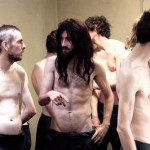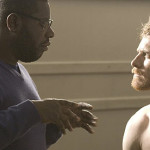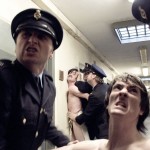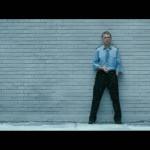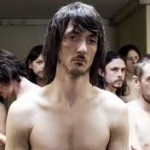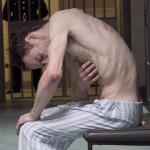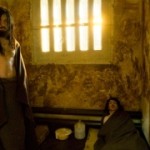A relatively brief review but one worthy of note. Steve McQueen has recently gained esteem and honours for his second feature, 12 Years A Slave, but his debut, Hunger, was in many ways every bit as remarkable. Hunger is the story of the Provisional IRA hunger striker Bobby Sands, one of 75 nationalist prisoners incarcerated in the notorious Maze prison in Northern Ireland in 1981, protesting for political status.
This is still a very raw wound for many on both sides. Great credit then to McQueen for having the courage to tackle the topic at all, still more for walking a tightrope with great bravado and avoiding the pitfalls of taking sides.
Even more remarkable is that he avoids pity, showing the worst of both parties in the conflict without fear or favour. As we hear the justifications from the protesters, their words and actions are juxtaposed with the words of Margaret Thatcher in condemning the IRA and restating the fact that the prisoners were convicted of murder and other serious crimes. If there is a moral it is that nobody benefits from conflict, a testament to the peace protest in Northern Ireland since the IRA cease-fire, even if renegade Republicans continue their campaign.
This is a harsh movie, not easy to watch – nor should it be. It comes in three acts: the first covers the dirty protest and the response of the authorities; the last shows Sands on his final days before death on his 66 day hunger strike. Sandwiched between them is one of the most remarkable shots in cinematic history – an unbroken 17-minute dialogue between Sands (Michael Fassbender) and a priest, Father Dominic Moran (Liam Cunningham) in which the priest urges Sands to abandon the notion of martyrdom and Sands explains his justification, personal and tactical. From Wikipedia:
The film is notable for an unbroken 17-minute shot, which has been mentioned to be one of the greatest film scenes in film history, in which a priest played by Liam Cunningham tries to talk Bobby Sands out of his protest. In it, the camera remains in the same position for the duration of the shot. To prepare for the scene, Cunningham moved into Michael Fassbender‘s apartment for a time while they practiced the scene between twelve and fifteen times a day.
This is acting of the highest calibre, stage acting brought to screen with verve and intensity. Worth also noting that Fassbender went on a crash diet for this part, to the point where his ribs were showing and he looked like a living corpse. This is living a role, a dedication above and beyond the call of duty.
As with 12 Years, McQueen’s style is taut and spare – a bleak, vivid and claustrophobic environment with, for the most part, minimal dialogue but acute and minute observation of tiny details while the prison guards go about their daily business. The camera lingers on a feather wafting above Sands’s bed; the snow falls in focus while the distorted face of the prison guard can be seen beyond.
Inevitably you can’t make a movie about this topic without angering people on all sides. Doubtless there are die-hard Republicans who to this day believe the protesters were justified in their actions. Never before has the old saying been portrayed in such relief: one man’s terrorist is another man’s freedom fighter; but McQueen’s attention to detail takes this above the standard biopic, above the docudrama style adopted for the initial section, and above the politics of the dispute.
Not a movie to be enjoyed, but essential viewing nonetheless, and without doubt worthy of the praise lavished upon the movie. As film debuts go, this is not far short of Welles‘s opening gambit in Citizen Kane, and I can think of no higher praise than that.



